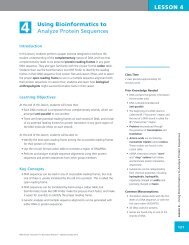WET LAB DNA Barcoding: From Samples to Sequences - Northwest ...
WET LAB DNA Barcoding: From Samples to Sequences - Northwest ...
WET LAB DNA Barcoding: From Samples to Sequences - Northwest ...
You also want an ePaper? Increase the reach of your titles
YUMPU automatically turns print PDFs into web optimized ePapers that Google loves.
<strong>WET</strong> <strong>LAB</strong><br />
34. Optional Graphing Extension Activity:<br />
Students can graph the log of the molecular weight of each band in their<br />
molecular weight standard (y-axis) against the distance each band traveled,<br />
in centimeters or millimeters (x-axis), either by hand or in a graphing program<br />
like Microsoft ® Excel. Students can then determine the exact molecular weight<br />
of their PCR product band(s) by measuring the distance traveled by their <strong>DNA</strong><br />
bands, and either plotting it on their graph or using their regression equation<br />
<strong>to</strong> solve for Y (molecular weight).<br />
Lab 4: Preparation of PCR <strong>Samples</strong><br />
for <strong>DNA</strong> Sequencing<br />
Teacher Preparation<br />
• Load the classroom computer with the Wet Lab PowerPoint slides.<br />
• Make copies of the Student Handout—Preparation of PCR <strong>Samples</strong> for <strong>DNA</strong><br />
Sequencing, one per student. These handouts are designed <strong>to</strong> be reused as<br />
a class set; students should write answers <strong>to</strong> questions and take notes on a<br />
separate sheet of paper or in their lab notebook.<br />
• Teachers may wish <strong>to</strong> have their students write out the lab procedures before<br />
the activity in their lab notebooks or on a separate piece of paper as a “prelab”<br />
exercise, which can be used as an “entry ticket” <strong>to</strong> class. During the<br />
lab, students may check off steps as they complete them and/or describe and<br />
draw pictures of their observations.<br />
• Queue your computer <strong>to</strong> one of the following tu<strong>to</strong>rials on <strong>DNA</strong> sequencing:<br />
‣ “The Sanger Method of <strong>DNA</strong> Sequencing” by the Wellcome Trust. Freely<br />
available at:<br />
http://www.wellcome.ac.uk/Education-resources/Teaching-and-education/<br />
Animations/<strong>DNA</strong>/WTDV026689.htm.<br />
‣ “Sanger Method of <strong>DNA</strong> Sequencing” video freely available from the<br />
Howard Hughes Medical Institute (HHMI). Video is 51 seconds long and<br />
requires an internet connection and speakers. Available at:<br />
http://www.hhmi.org/biointeractive/dna/<strong>DNA</strong>i_sanger_sequencing.html.<br />
• Set up student work stations by distributing supplies and reagents needed for<br />
each group, as described above under Materials. It is suggested that reagents<br />
from the s<strong>to</strong>ck bottles contained in the <strong>DNA</strong> Clean & Concentra<strong>to</strong>r-5<br />
(capped columns) kit be aliquoted for student groups and labeled as<br />
described in Student Handout—Preparation of PCR <strong>Samples</strong> for <strong>DNA</strong><br />
Sequencing. This information is found in Teacher Resource—Aliquoting <strong>DNA</strong><br />
<strong>Barcoding</strong> Reagents for Labs 1–4.<br />
35. Show Slide #21, “Preparation of PCR <strong>Samples</strong> for <strong>DNA</strong> Sequencing,” as<br />
students enter the room.<br />
Wet Lab – <strong>DNA</strong> <strong>Barcoding</strong>: <strong>From</strong> <strong>Samples</strong> <strong>to</strong> <strong>Sequences</strong><br />
341<br />
©<strong>Northwest</strong> Association for Biomedical Research—Updated Oc<strong>to</strong>ber 2012
















